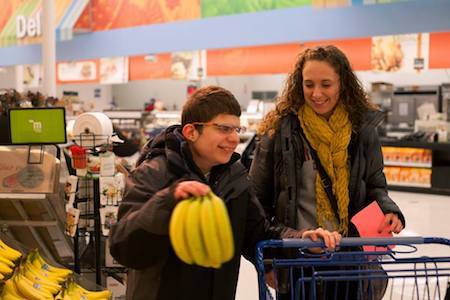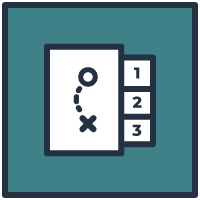Recommendation 3: Advocate for Community Activities and Living
Advocate for students to have community activities and living services included in their transition plans, with an intended outcome of meaningful participation and membership in their communities after graduation.

Why This Is Important
We know that most young adults with deaf-blindness and additional disabilities live at home with their parents after high school and are socially isolated (Petroff & Panscofar, 2018). An ideal goal for a student’s post-school life would be to have individualized supports that enable them to participate in community activities of their choice and experience rich full days that match their interests and preferences.
In the past, Medicaid Waiver services were sometimes used to fund services for individuals with deaf-blindness and additional disabilities in sheltered workshops or day activity centers—settings that are typically segregated and where staff members are often the only people without disabilities. The Centers for Medicare and Medicaid (CMS) Final Settings Rule, issued in 2014, is intended to increase the quality of these services. Home and community-based services funded by Medicare and Medicaid must now “provide full access to the benefits of community living and offer services in the most integrated settings” (CMS, 2014a). In addition, person-centered planning is required to develop a service plan that defines and delivers services in “a manner that reflects personal preferences and choices” (CMS 2014b).
Also influencing the quality and location of adult services funded by Medicaid or other public funds, is the Integration Mandate of the ADA. In 1999, the Supreme Court ruled that Title II of the ADA prohibits unjustified segregation of people with disabilities when community-based options are appropriate, when affected persons do not oppose them, and when the services can be reasonably accommodated (Olmstead v. L.C., 527 U.S. 581 1999). Therefore, “schools and education agencies that unnecessarily segregate students with disabilities in their pre-vocational transition programs may be liable under the ADA for discrimination” (Hill, Kline, & Richards, 2018). The U.S. Department of Justice prevailed in suits in Rhode Island and Oregon against state education agencies, a local school district, and state departments of developmental disabilities and VR services, for unnecessary segregation of students and adults with disabilities by preparing them for sheltered work rather than giving them information and experience in community employment (Hill, Kline, & Richards, 2018). There has not yet been a suit filed about preparing students for segregated non-work options rather than community activities. For more information about integrated settings and Olmstead v. L.C., see Preparing Transition-Age Youth with Disabilities for Work.
What State Deaf-Blind Projects Can Do
1. Learn about services in your state to assist people with long-term support needs to live, learn, and recreate in their communities.
Most likely these services will be available through Medicaid Waivers offered by state developmental disabilities services to qualified children and adults. For information about waiver programs in your state, see the State Waivers List.
Learn who is eligible, what the services look like, and how and when to apply. Ensure that families, school staff, and young adults have access to this information to enable them to make informed choices.
2. Support IEP teams in their use of a person-centered planning process to identify students’ interests and select community activities.
Advocate for person-centered planning information to drive the development of postsecondary goals related to community participation and living. Encourage teams to include activities in students’ IEPS for making connections with agencies, being determined eligible, and applying for services.
3. Advocate for transition plans that result in a meaningful life.
Offer resources that help families, students, and IEP teams define what an ideal day could look like for an individual once they exit school. Define the most effective supports, rather than assume that he or she will transition to a program. Include information about transition to adult health care for children with special health care needs.
4. Learn what your state is doing to meet CMS final settings rules.
Learn about the new rule and find your state’s plan.
5. Sponsor training from the Council on Quality Leadership.
Council on Quality Leadership training helps participants learn to provide services and programs that support access to a meaningful life and community membership.
6. Educate adult agencies, families, and students about the role of support service providers.
To ensure access to community activities, individuals with deaf-blindness need skilled support staff who can provide information about the environment and their surroundings. Support service providers provide assistance not necessarily included with interpreting, such as guiding and relaying visual information. Sometimes they do light interpreting (e.g., at a bank or store).
Promising Examples
The Community’s Calendar
The Community’s Calendar is a framework created by Marc Gold and Associates. It’s used by individuals with disabilities, families, friends, and supporters to develop personalized activity plans based on opportunities offered in one's local community (Callahan, Shumpert, & Mast, 2001). It begins by getting to know an individual through the process of discovery, the same process used in customized employment. In a community calendar, however, information about the individual is used to identify opportunities for recreation and leisure.
Transition and Postsecondary Programs for Students with Intellectual Disabilities (TPSID)
Post-school options for students with intellectual disabilities now include college. The TPSID project piloted campus-based programs where students participated in education, recreation and leisure activities, and employment alongside their same-age peers without disabilities. Students participating in these programs earned certificates or a credential upon completion.
Natural Support Networks
The Council on Quality Leadership (CQL), which assists communities and organizations to improve quality of life for individuals with disabilities, emphasizes the importance of natural support networks (e.g., supportive family members and close friends) for quality of life. Member CQL agencies strive to build life-long natural support networks for the people they serve, including maintaining or re-establishing family relationships and building connections with community organizations and members who have similar interests.
Day Habilitation without Walls
As states modify their day habilitation programs to comply with the CMS final rules regarding access to community and person-driven services, we should begin to see more programs that resemble the New York program, Day Habilitation without Walls—habilitation services that take place in the community and are driven by individual preferences and interests. The following are examples of agencies using this approach: General Human Outreach in the Community, Inc., Rewarding Environments for Adult Living, Inc., and The Viscardi Center. These services are typically funded by Medicaid Waivers.
